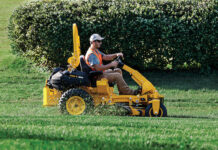Innovation. It’s a term that gets tossed around a lot in our industry. As product developers and manufacturers, the pursuit of the next great idea is what gets us up each morning. But there’s a big difference between new and better, and innovating for innovation’s sake should never be the end goal.
A Customer-First Approach
While most innovation begins with an idea, great innovation begins with the customer. At the end of the day, the merit of a new product, feature or service is defined by the problems it solves for the individuals it serves. As a result, developers and manufacturers must prioritize a customer-first approach to innovation, especially in today’s lawn and landscaping industry, where every investment counts.
At Cub Cadet®, the process begins with the end-user. Instead of sitting behind a computer coming up with ways to innovate, we take the time to listen to landscapers, fleet managers and municipalities to better understand their businesses and, more importantly, their pain points. From there, we set out to develop products and features to help solve their problems.

One example of putting this philosophy into practice was our approach to designing Cub Cadet stand-on mowers. Before even building our first prototype, the team engaged more than 100 landscapers about their experiences with stand-ons. We learned about the traits, features and quirks they liked and disliked most, and even their ideas about what could be improved — all valuable information for our product development team and engineers. But the collaborative process didn’t end there.
The end-users were brought along at each step of the prototyping journey, where they were given opportunities to evaluate the progress early and often. Changes and tweaks were continuously made based on their feedback until we finally had a product that was ready to enter our professional test-drive process — a final step where all Cub Cadet commercial equipment spends a minimum of one season with landscapers in the field before officially launching.
From a distance, Cub Cadet PRO XTM commercial stand-on mowers may not scream innovation. There are no flashy design overhauls or wild features. But if the devil is in the details, then that’s where the innovation is to be found here. Whether it’s the adjustable suspension platform and pads for operator comfort, the deck lift with easy-to-use levers and magnetic pins, or the 24-inch tires that easily hop curbs, these carefully considered features all add up to a mower that’s greater than the sum of its parts.
Out Of Left Field
While measured progress and improvements are one means of innovating in the lawn and landscape space, some problems require a radically different approach. These are the challenges that force us to think outside the box, to question the ways things have always been done and to take a leap of faith. The kind of innovation that turns heads, raises eyebrows and makes a statement out of the gates.
At Cub Cadet, we don’t shy away from this kind of innovation. And we certainly don’t mind introducing something to the market that’s a little unexpected and different. In fact, our innovation story in the commercial space started with some outside-the-box thinking that resulted in a new technology to address a very real problem.
Many of our dealers live in areas with uneven and sloped terrain that has historically been difficult for their customers to navigate. On a traditional lap bar zero-turn mower, the operator must cut across hills with the front wheels elevated at an angle, since the front casters do nothing to keep the mower straight and all the stabilizing force rests on the rear wheels. Moreover, turning while on a steep incline often causes the wheels to kick out, tearing up the grass and ruining cut lines. Consequently, we set out to create a way to better handle sloped terrain. The result? We boldly side-stepped traditional lap bar controls and introduced an industry-exclusive four-wheel steering technology. In other words, we decided to build steering wheel zero-turn mowers.
There’s no denying they stand out. Having become so accustomed to lap bar units in the industry, landscapers are often left scratching their heads when they first see a steering wheel on a commercial zero-turn mower. But as they say, the proof is in the pudding, and skeptics soon became believers once they had a chance to try one out. Unlike lap bar units, the steering wheel gives operators control of the two front wheels, which helps hold a line comfortably on hills. And the true innovation comes into play with the four-wheel steering system, where linkages run from the front wheels to the transmission, allowing the inside rear wheel to counterrotate in a zero-turn. This helps to minimize the chances of tearing up the turf — an issue many landscapers face on both sloped and flat terrain.
Pushing our innovative thinking a step further, we expanded beyond single-wheeled mowers and introduced dual rear wheels on select steering wheel zero-turn units to help increase slope traction up to a 46% grade and added self-leveling air-ride seats with 30 degrees of side-to-side swivel designed to improve ride comfort on hills. When you put it all together, you suddenly have a mower that looks very different than what’s out there. Yet despite these seemingly radical changes, the innovation here is rooted in the same philosophy that inspired the nuanced innovations in our stand-ons: solving real problems for our customers.
The Right Innovation For You
The saying goes “don’t knock it until you’ve tried it,” and I’m an avid supporter of this attitude. It’s easy sticking with what you know, but real progress starts with doing something different. But I also believe in a “don’t buy it until you’ve tried it” mentality. Innovation can come in all shapes and sizes, but just because something is innovative doesn’t mean it’s right for you and your business.
My advice: demo it. Visit your local dealer and request to demo a new product that’s caught your eye. Or better yet, bring your dealer a challenge you’re facing and see if they know of any products that might make your life easier. At Cub Cadet, we spend a lot of time and resources educating and training dealers on our new products, how they work and who they benefit. So, partner with your dealer and make sure you’re constantly looking at new products. For all you know, the answer to your business’s greatest problem might be just around the corner.











![[VIDEO] Dickies®: Discover Workwear That’s Anything But Uniform](https://turfmagazine.com/wp-content/uploads/2023/06/1647663814-4b1a2a7742790a9b1e97a3b963477850192e1d6a9dfba9b07214a77bae25d6e3-d-218x150.jpg)































![[VIDEO] Dickies®: Discover Workwear That’s Anything But Uniform](https://turfmagazine.com/wp-content/uploads/2023/06/1647663814-4b1a2a7742790a9b1e97a3b963477850192e1d6a9dfba9b07214a77bae25d6e3-d-324x160.jpg)